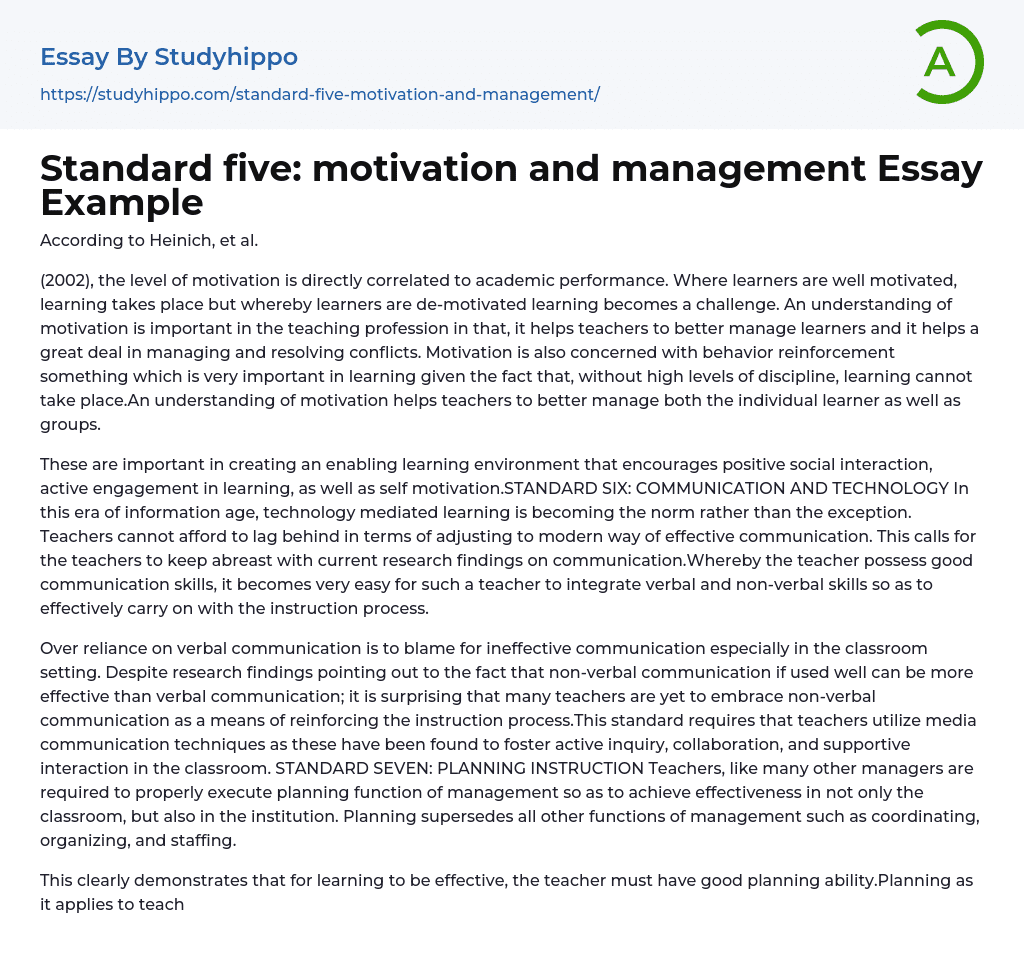The statement made by Heinich and colleagues is as follows:
Based on a 2002 study, motivation is closely tied to academic performance. When learners are motivated, they are more likely to learn, but lack of motivation makes learning difficult. Hence, teachers should grasp the concept of motivation as it helps them manage their students and handle conflicts. Motivation also includes behavior reinforcement which is crucial for effective learning since discipline is necessary. In general, comprehending motivation aids in managing individual learners and groups efficiently.
Creating a favorable learning environment that promotes social interaction, active participation, and self-motivation is crucial. In this era of technology-based learning, it is essential for teachers to keep abreast of the latest communication research and adapt to modern communication methods. Skilled communication abilities allow educators to integrate both verbal and nonverbal strategies into their teachings for efficient instruction.
Studies indicate
...that over-reliance on verbal communication can hinder effective classroom communication. To enhance instruction, educators should adopt nonverbal communication methods, which may prove more successful than spoken language. Moreover, media-based communication strategies should be employed as they foster engagement, cooperation, and positive interaction among learners. According to Standard Seven (Planning Instruction), efficient planning is vital for both individual classroom achievement and institutional triumph and supersedes coordination, organization, and staffing.
Effective learning requires teachers to have good planning skills, which involves planning for lessons, schemes of work, and educational goals. Planning is important in simplifying subject matter for learners at the lesson level. A well-structured plan should include the introduction, body, and conclusion of a lesson based on the allocated time and content to be covered.
Teachers should not solely prioritize academic instruction, but also take into account
individual societal needs. To ensure that knowledge obtained in school is applicable to the learners' surroundings, teachers should simplify subject matter by aligning it with community occurrences. Proper assessment is also crucial in achieving the goals and objectives of instruction. Teachers must possess knowledge of formal and informal assessment strategies to determine the outcome of the learning process. Through assessment, teachers can verify if the aims of instruction are being met based on learners' retention rates.
Assessing students' achievements and level of subject matter retention can be done through administering continuous assessments and sit-in exams. These assessment strategies are effective tools for teachers to determine the abilities of learners in practical situations. Apart from measuring intellectual development, assessment tests can also measure social and physical development - all of which are objectives of education. Professional growth is essential to teaching, and teachers need to continually update themselves with current knowledge through reflective accounts on their teaching practice. Reflective practice is important since it largely determines the effectiveness of a teacher's practice. STANDARD NINE: REFLECTIVE PRACTICE: PROFESSIONAL GROWTH
If teachers do not keep up with current trends in education, instruction may fail and conflicts may arise. To avoid this, teachers should have a positive attitude that allows them to appreciate the contributions of students, parents, government representatives, and other professionals in the learning community. By understanding the vital roles that others play in the instructional process, teachers can ensure its success. Furthermore, as teaching and learning involve multiple sectors, it is important to involve parents, guardians, sponsors, and nearby communities in the educational decision-making process. This is essential to make the instructional process successful and is outlined in
Standard Ten: School and Community Involvement.
Proper communication is crucial for the success of the instruction process. This involves teachers, students, sponsors, colleagues, guardians, families and the school community. It has been discussed that the ten standards outlined by INSTASC are essential for effective teaching and learning. These include Content Pedagogy, Student Development, Diverse Learners, Multiple Instructional Strategies, Motivation and Management, Communication and Technology, Planning Instruction, Assessment, Reflective Practice: Professional Growth, and School and Community Involvement. Internalization of these standards is critical for success. Teachers who understand and apply these standards are more likely to be effective than those who do not. (Reference: Gollnick, D. , and Chinn, P.)
The book "Multicultural education in a pluralistic society" (6th edition) written by Heinich et al. (2002) and published by Merrill/Prentice Hall in NJ contains information on the topic within pages 200-245.
Page 80-103 of the 7th edition of Pearson Education Inc.'s "Instructional media and technologies for learning".
- Academia essays
- Higher Education essays
- Language Learning essays
- Studying Business essays
- Education System essays
- Study essays
- First Day of School essays
- Scholarship essays
- Pedagogy essays
- Curriculum essays
- Coursework essays
- Studying Abroad essays
- Philosophy of Education essays
- Purpose of Education essays
- Brainstorming essays
- Educational Goals essays
- Importance Of College Education essays
- Brown V Board of Education essays
- The Importance Of Higher Education essays
- Online Education Vs Traditional Education essays
- Academic And Career Goals essays
- Academic Integrity essays
- Brown Vs Board Of Education essays
- Distance learning essays
- Technology in Education essays
- Vocabulary essays
- Writing Experience essays
- Importance of Education essays
- Early Childhood Education essays
- Academic Degree essays
- Academic Dishonesty essays
- School Uniform essays
- Academic writing essays
- Cheating essays
- Bachelor's Degree essays
- MBA essays
- College Life essays
- Grade essays
- Diploma essays
- Phonology essays
- Sentence essays
- Filipino Language essays
- Pragmatics essays
- Millennium Development Goals essays
- History Of Education essays
- Graduate School essays
- Middle School essays
- School essays
- Special Education essays
- University essays




